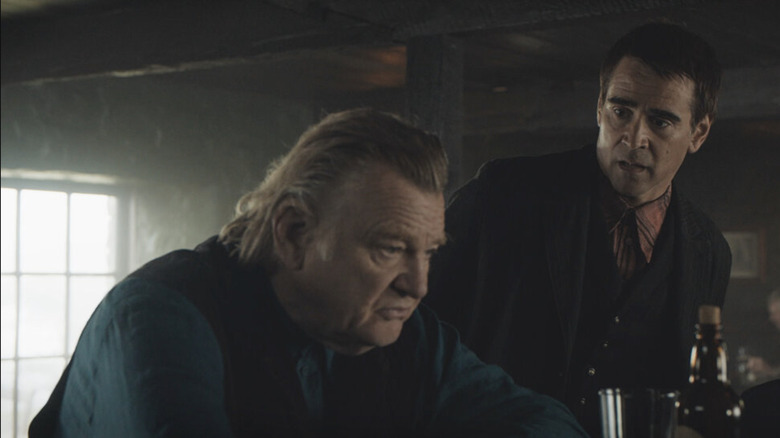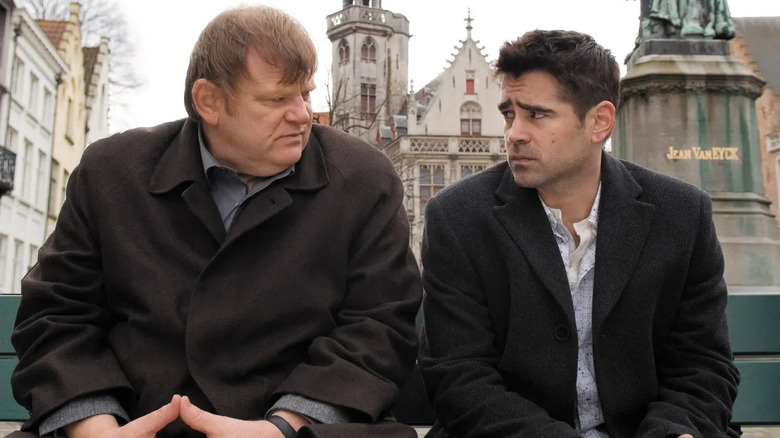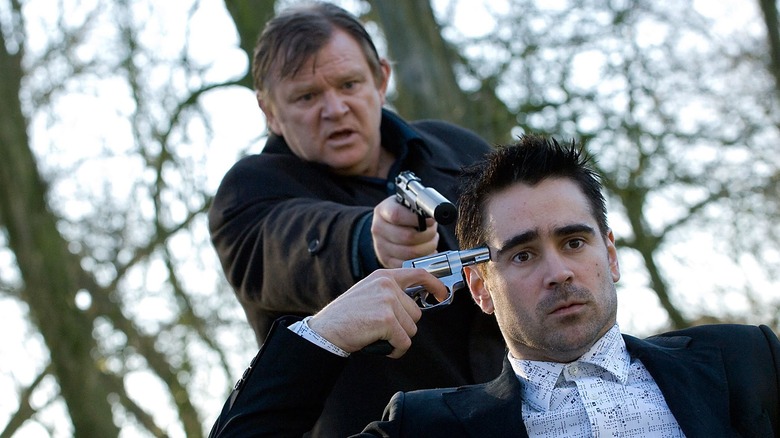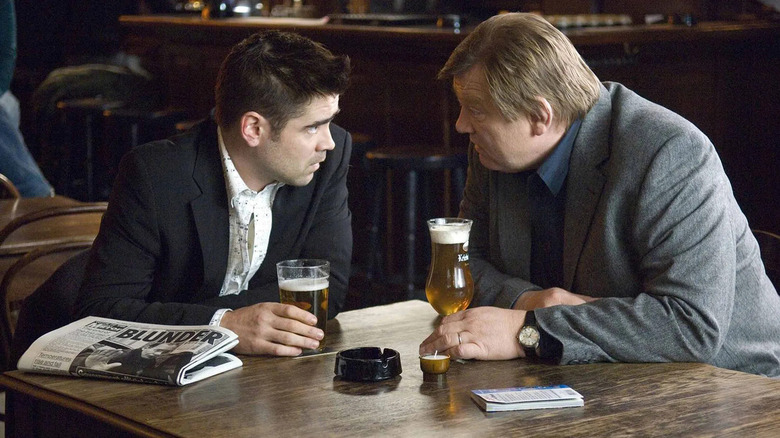Director Martin McDonagh Sees The Banshees Of Inisherin As An In Bruges Sequel Gone Wrong
"The Banshees of Inisherin" was a homecoming for Martin McDonagh. After going stateside for his last two films, "Seven Psychopaths" and "Three Billboards Outside Ebbing Missouri," he returned to Ireland, his homeland, for his aforementioned fourth feature. The setting wasn't the only familiar part for McDonagh; he once again cast Colin Farrell and Brendan Gleeson, the stars of his film "In Bruges."
As was true of "In Bruges," "The Banshees of Inisherin" is a duet that lives and dies through the performances of Farrell and Gleeson. They aren't the only actors in either film, but the equally humorous and tear-jerking dynamics their characters share give the pictures their soul.
During an appearance on "Late Night With Seth Meyers," McDonagh said he and his actors were aware of the shadow they worked in while making "The Banshees of Inisherin." His goal was to both recapture the magic of the trio's first film while still doing something new.
A break-up sequel
Seth Meyers, who called "In Bruges" one of his favorite films, told Martin McDonagh that he considers it a platonic love story: "You watch them actually, like, fall in love and how close and how important male friendship can be." During "In Bruges," Ray (Colin Farrell) and Ken (Brendan Gleeson) are two hitmen laying low after a job gone wrong. They hide out in, well, Bruges, a classical Belgian city. In its early parts "In Bruges" plays like a straight buddy comedy; Ken's eager to sight-see while Ray just wants to mope.
Meyers noted in turn that, "[Banshees] is sort of the perfect reverse, which is this breakup story between two male friends." Colm (Gleeson) pushes his buddy Pádraic (Farrell) away and whenever Pádraic tries to reconnect, he just gets himself and his friend hurt more and more.
McDonagh agreed with Meyers, "it's literally almost like a sequel that goes wrong from the very first five minutes." It's not just the premises that are inverted either. The films' settings — baroque Bruges compared with rural Ireland — conjure up very different atmospheres. Most compellingly, Farrell and Gleeson essentially swap roles from one film to the next.
Swapping roles
Take "The World's End," the final chapter of Edgar Wright's Three Flavours Cornetto trilogy. In the first two films ("Shaun of the Dead" and "Hot Fuzz"), Simon Pegg was the straight man and Nick Frost was the comedic relief, but the pair flipped things around for "The World's End." The film sees Gary (Pegg) never growing up, while Andy (Frost) is the grounded one. Seeing the two actors together but with their usual routine switched around made their performances greater.
The same thing's true of Colin Farrell and Brendan Gleeson in "The Banshees of Inisherin" compared to "In Bruges." Ken reaches out to Ray, encouraging him to enjoy Bruges while Ray brushes him off. Ken, who knows a thing or two about regret, also pushes Ray to live; the younger man accidentally shot a young child in the hit which kicked off the story, and is wracked with suicidal despair. Ken becomes determined to save Ray's life, even when their boss Harry (Ralph Fiennes) orders his death. In the end, Ken gives his life to save Ray.
In "The Banshees of Inisherin," it is Gleeson's turn to play the grump, while Farrell is the good-hearted friend always being turned away. It's not hard to imagine "The Banshees of Inisherin" with the kind-eyed Gleeson as Pádraic while Farrell channels his aloof pretty boy persona from the 2000s and plays Colm. The actors staying in their comfort zones would be an easier movie, but also a lesser one.
Character comparisons
This doesn't mean that Ray and Colm are one-to-one clones of each other or Ken and Pádraic for that matter. While they face similar struggles, it often comes from a different place.
Ray and Colm both struggle to live. With the latter, it's because he can't bear living a long life knowing what he's done. Colm, though, is having a mid-life crisis and has decided to be stingy with his time because he has little of it left. Both characters explore depression, but Ray's is a youthful strain while Colm's is aged. Ken and Pádraic have ulterior motives, too. Ken is hoping for a vicarious redemption if he can set Ray on the right path. Pádraic, meanwhile, has few friends and doesn't want to lose one of them.
Both films end in uncertainty, though "In Bruges" is the more optimistic. Ray is loaded into an ambulance and narrates, "I really, really hoped I wouldn't die." He may not get his wish, but his character arc is complete. "The Banshees of Inisherin," though, lacks any resolution at all. Pádraic and Colm have done irreparable harm to themselves and now have to live with it, and each other.
Martin McDonagh acknowledged the comparative darkness of "The Banshees of Inisherin" on "Late Night With Seth Meyers," saying:
"We also wanted to do something that was different, that wouldn't displease an 'In Bruges' fan, to have the humor and all of that stuff, but to go to a slightly stranger and maybe sadder place. 'In Bruges' is pretty sad, too, but just to be completely free to take an 'In Bruges' audience to a different sort of place.
Sequels don't have to be carbon copies. Brave artists explore even similar territory with a new lens. Brendan Gleeson, Colin Farrell, and Martin McDonagh did just that going from "In Bruges" to "The Banshees of Inisherin."



